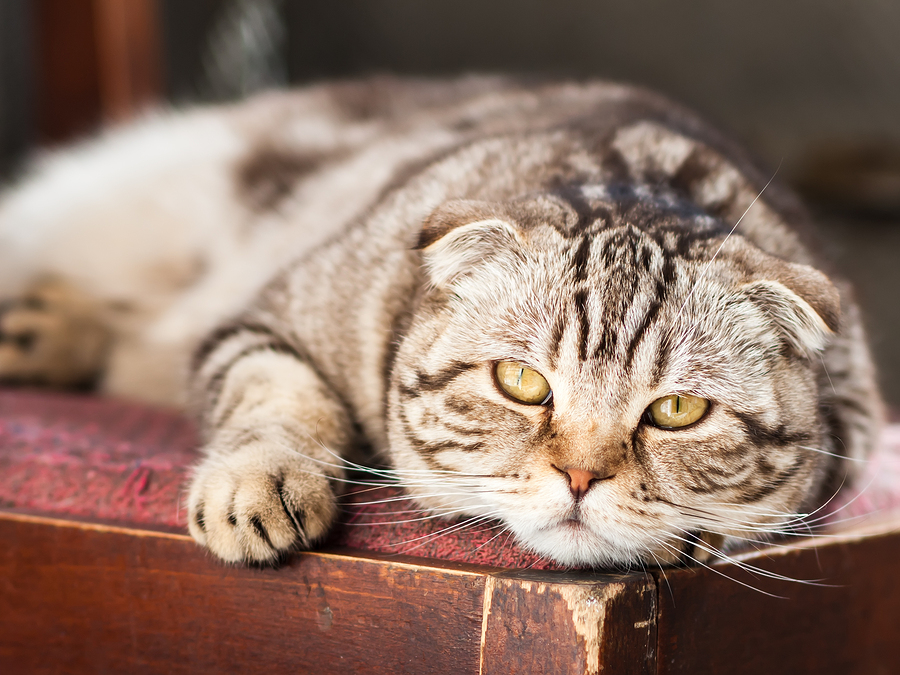This post may contain affiliate links. We are compensated for referring customers to our affiliate partners.
A growing population of cats are developing diabetes mellitus, which is the inability to produce enough insulin to balance blood sugar or glucose levels. There are serious health problems that can come as a result of the disease including dehydration, weight loss, vomiting, reduced appetite, depression, impaired motor function, coma, or even death. Diabetes in felines is not something to be taken lightly, and the responsibility falls on the owner to monitor and prevent diabetes in their loved one.
What are the Main Causes of Diabetes in Cats?
There are two main causes for feline diabetes, and they often time go hand-in-hand.
1) High-Carbohydrate Diets
The majority of cats in the United States are fed a high-calorie, high-carbohydrate diet loaded with grains. Cats are natural carnivores, and need a diet high in fatty proteins. Unfortunately, a lot of cat food is loaded with carbs, making up nearly 80% of its contents. Carbs break down into sugar. Since your cat is not supposed to consume large amount of carbs, they are essentially left with excess sugar. Excess sugar leads to diabetes. Cats very much desire to maintain their primal needs when it comes to their diets. A cat’s diet should consist of approximately 50% protein, 35% fat, and 12-15% carbohydrates. A study has revealed that when given an option, cats will chose high-protein food over high-carb food, even when the portion size of the protein-based food was smaller than that of the carbohydrate-based food. So, give your cat an option! Or better yet, provide them with the protein-based diet they crave, and don’t impact their health with carbohydrate-based diets.
2) Sedentary Lifestyle
Let’s face it, cats are not dogs. While dogs live a very active lifestyle cats…do not. Most don’t get nearly enough exercise to provide health benefits. Cats that lay around all day, especially while their owners are gone, are not maintaining good cardiovascular conditioning. Cats should get at least 20 minutes of daily aerobic exercise, and that’s a MINIMUM. Otherwise, your cat will not burn the calories being consumed, which can lead directly to the development of diabetes.
These two factors often combine and result in obesity, which then results in diabetes. Obesity is, without a doubt, the leading cause of feline diabetes. Recent research by the Association for Pet Obesity Prevention shows that 58% of cats are overweight, and 28% are considered obese. Yet the worst part is that 90% of cat owners think their overweight cat is actually a normal weight! Owners who don’t accept the fact that their cat’s weight is a problem are themselves contributing to their cat’s diabetes and other health issues.
What are the Warning Signs of Diabetes?
There are a number of warning signs that may tip you off that your cat is suffering from diabetes. These include increased thirst and urination, and inappropriate elimination. There could also be a change in appetite and, ironically, weight loss. Your cat may also change the way it walks, and show signs of decreased activity, weakness, and depression.
Diabetes can be diagnosed based on the cat’s symptoms, a physical examination, lab tests, and a presence of elevated sugar levels in blood and urine samples.
Ketoacidosis is also a serious symptom of diabetes that needs to be addressed immediately. Ketoacidosis occurs when broken down fat products build up in the bloodstream, causing the blood to become more acidic. Common signs of ketoacidosis are very similar to the signs of diabetes – loss of appetite, vomiting, diarrhea, and weakness. The weakness can sometimes elevate to the point of collapse, dehydration, and respiratory disruption. Any cat suspected of suffering diabetic ketoacidosis should be seen by a veterinarian immediately. Ketoacidosis needs to be properly treated with IV’s, insulin, potassium medication, and antibiotics.
Cat Food for Overweight Cats
Cats that are overweight must be fed a portion-controlled, balanced, and species-appropriate diet. A big problem with feeding for cats is that they graze, meaning food is kept out all day and night for them to eat. The ideal nutrition for cats is whole, fresh, unprocessed animal meat and organs, with a small amounts of vegetables. These can come in the form of high-quality canned food and/or a raw diet. Owners should shy away from dry food, as it is this processed food that is often loaded with excess carbohydrates and does not provide your cat with the proper nutrients necessary to maintain a healthy lifestyle. There are a surplus of blogs on the website that will provide you further information on what diet is most suitable for your species of cat.
It is extremely important that your cat is slowly weened onto a diet. Your cat should lose no more than a half-pound per month, in order to avoid triggering a severe and potentially deadly case of hepatic lipidosis. Hepatic lipidosis occurs when there is inappropriate fat infiltration into the liver. If weight is lost too quickly, the liver will be overwhelmed trying to mobilize and process fat stores, resulting in liver failure. Your feline’s weight loss should be a process, taken slow and steady.
Feline Diabetes is Preventable, but it starts With YOU!
Measures can be taken to be sure your cat avoids diabetes mellitus. Being proactive and promoting a healthy diet can easily lead to the prevention of diabetes. Be sure your cat avoids a sedentary lifestyle, and eats a healthy diet with fresh foods high in protein. A healthy cat is not only a happy cat – but a happy owner as well!



